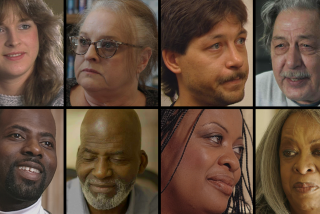Welfare ‘Truth Squad’ Battles Stereotype
DEERFIELD, Ill. — Poised and well-spoken, Chris Jordan seems to fit right in with the Rotarians meeting in this comfortable, politically conservative Chicago suburb--except he’s only recently off welfare and no stranger to living on the streets.
Jordan is a black man delivering an inner-city message to white suburbia, amid the goulash and fried fish served up at a recent Rotary Club luncheon.
“A welfare recipient is not a deadbeat dad and is not lazy,” the unemployed 33-year-old Jordan tells the bankers, investment counselors and shop owners. “He wants to work.”
Jordan is one of seven current members of the so-called Welfare Truth Squad, organized this year to present their life stories as evidence that the stereotype of welfare recipients is flawed, that a more faithful image is a person trapped in poverty, not willingly on the dole.
The Truth Squad accepts invitations to speak anywhere in Illinois, but figures the suburbs hold the richest promise.
“That’s where, when the politicians are posturing, they speak in code words” that obscure the complexities of the issue, said Roger Bennett, who coordinates the squad for the Jewish Council on Urban Affairs.
Jordan had no trouble selling himself to the Deerfield Rotarians. And his message that there are many more who don’t answer to the stereotype got a respectful hearing, convincing to some, doubtful to others.
“It’s a side of the story we don’t hear enough about,” said Robert D. Franz, Deerfield village manager. “It was refreshing to hear him. Enlightening to hear him.”
Peter A. DuBois, an investment account executive, found Jordan a sympathetic, employable person caught “in a horrible predicament through no fault of his own.”
“But maybe Chris is an exception. For every one pumping out babies, how many are there like Chris?” said DuBois, 33.
Like the dozens of other jobless or low-income men who have been on the truth squad, Jordan had three months of training and practice with skilled storytellers before going out with the message.
At the Deerfield Rotary Club, Jordan recalled how as a high school football player at Boyd H. Anderson High School in Fort Lauderdale, Fla., he was on top of the world.
“I thought, ‘Man, it doesn’t get any better than this,’ ” he said.
Graduation was followed by six years in the Army and five years working in a machine shop.
Even when the machine shop closed, he figured there would be no problem getting another good job.
“But I found I wasn’t the only one filing for a job, and the other people had college educations,” Jordan said.
He landed a job at a fast-food chicken restaurant. When the night shift he was working shut down, he was laid off.
He became one of those anonymous faces in the newspaper photographs showing the crowds of 500 that report for the 50 jobs at a new hotel or factory.
Next stop, welfare. Then “earn fare,” where he worked for $4.25 an hour for six months but was not kept on as a permanent employee.
“That’s when I became homeless,” Jordan said. “It’s very unmotivational. There’s no place to take a bath, no permanent address, you can’t afford transportation and you don’t know where your next meal is coming from.”
Several months later, he got room and board at a small hotel in exchange for painting jobs. He’s still looking for full-time work.
Transportation is a big issue. Thousands of blue-collar jobs have migrated to the suburbs. Without a car or direct public transportation, low-income and welfare recipients are isolated from these potential jobs.
“If the inner cities across the nation don’t have jobs, there should be a way for people to get to the suburbs,” said Scott Fishkin, 44, a financial planner and Rotarian.
“I think most people see welfare recipients as someone who is stealing from the government, lazy, uneducated and unwilling to work,” Fishkin said. “And I think that’s a gross injustice.”
More to Read
Sign up for Essential California
The most important California stories and recommendations in your inbox every morning.
You may occasionally receive promotional content from the Los Angeles Times.










